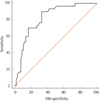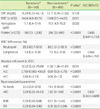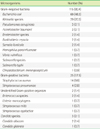1. Paolucci M, Landini MP, Sambri V. Conventional and molecular techniques for the early diagnosis of bacteraemia. Int J Antimicrob Agents. 2010. 36:Suppl 2. S6–S16.

2. Bates DW, Lee TH. Rapid classification of positive blood cultures. Prospective validation of a multivariate algorithm. JAMA. 1992. 267:1962–1966.

3. Groeneveld AB, Bossink AW, van Mierlo GJ, Hack CE. Circulating inflammatory mediators in patients with fever: predicting bloodstream infection. Clin Diagn Lab Immunol. 2001. 8:1189–1195.

4. Jaimes F, Arango C, Ruiz G, Cuervo J, Botero J, Vélez G, et al. Predicting bacteremia at the bedside. Clin Infect Dis. 2004. 38:357–362.

5. Raz R, Ben-Israel Y, Gronich D, Granot E, Colodner R, Visotzky I. Usefulness of blood cultures in the management of febrile patients in long-term care facilities. Eur J Clin Microbiol Infect Dis. 2005. 24:745–748.

6. Nakamura T, Takahashi O, Matsui K, Shimizu S, Setoyama M, Nakagawa M, et al. Clinical prediction rules for bacteremia and in-hospital death based on clinical data at the time of blood withdrawal for culture: an evaluation of their development and use. J Eval Clin Pract. 2006. 12:692–703.

7. Shapiro NI, Wolfe RE, Wright SB, Moore R, Bates DW. Who needs a blood culture? A prospectively derived and validated prediction rule. J Emerg Med. 2008. 35:255–264.

8. Peduzzi P, Shatney C, Sheagren J, Sprung C. The Veterans Affairs Systemic Sepsis Cooperative Study Group. Predictors of bacteremia and gram-negative bacteremia in patients with sepsis. Arch Intern Med. 1992. 152:529–535.

9. Fontanarosa PB, Kaeberlein FJ, Gerson LW, Thomson RB. Difficulty in predicting bacteremia in elderly emergency patients. Ann Emerg Med. 1992. 21:842–848.

10. Pfitzenmeyer P, Decrey H, Auckenthaler R, Michel JP. Predicting bacteremia in older patients. J Am Geriatr Soc. 1995. 43:230–235.

11. Wyllie DH, Bowler IC, Peto TE. Relation between lymphopenia and bacteraemia in UK adults with medical emergencies. J Clin Pathol. 2004. 57:950–955.

12. Yoshida T, Tsushima K, Tsuchiya A, Nishikawa N, Shirahata K, Kaneko K, et al. Risk factors for hospital-acquired bacteremia. Intern Med. 2005. 44:1157–1162.

13. Abidi K, Khoudri I, Belayachi J, Madani N, Zekraoui A, Zeggwagh AA, et al. Eosinopenia is a reliable marker of sepsis on admission to medical intensive care units. Crit Care. 2008. 12:R59.

14. Wibrow BA, Ho KM, Flexman JP, Keil AD, Kohrs DL. Eosinopenia as a diagnostic marker of bloodstream infection in hospitalized paediatric and adult patients: a case-control study. Anaesth Intensive Care. 2011. 39:224–230.

15. Park DH, Park K, Park J, Park HH, Chae H, Lim J, et al. Screening of sepsis using leukocyte cell population data from the Coulter automatic blood cell analyzer DxH800. Int J Lab Hematol. 2011. 33:391–399.

16. Williams J, Bellamy R. Fever of unknown origin. Clin Med. 2008. 8:526–530.

17. Hoffbrand AV, Moss PAH, editors. Essential Haematology. 2006. 5th ed. Oxford: Blackwell Publishing Ltd.;101–104.
18. Sekhon SS, Roy V. Thrombocytopenia in adults: a practical approach to evaluation and management. South Med J. 2006. 99:491–498.

19. Afessa B, Greaves WL, Frederick WR. Pneumococcal bacteremia in adults: a 14-year experience in an inner-city university hospital. Clin Infect Dis. 1995. 21:345–351.

20. Watanakunakorn C, Bailey TA. Adult bacteremic pneumococcal pneumonia in a community teaching hospital, 1992-1996. A detailed analysis of 108 cases. Arch Intern Med. 1997. 157:1965–1971.

21. Kollef MH, Shorr A, Tabak YP, Gupta V, Liu LZ, Johannes RS. Epidemiology and outcomes of health-care-associated pneumonia: results from a large US database of culture-positive pneumonia. Chest. 2005. 128:3854–3862.

22. Leung WS, Chu CM, Tsang KY, Lo FH, Lo KF, Ho PL. Fulminant community-acquired Acinetobacter baumannii pneumonia as a distinct clinical syndrome. Chest. 2006. 129:102–109.

23. Aliberti S, Amir A, Peyrani P, Mirsaeidi M, Allen M, Moffett BK, et al. Incidence, etiology, timing, and risk factors for clinical failure in hospitalized patients with community-acquired pneumonia. Chest. 2008. 134:955–962.

24. Hsu CY, Fang HC, Chou KJ, Chen CL, Lee PT, Chung HM. The clinical impact of bacteremia in complicated acute pyelonephritis. Am J Med Sci. 2006. 332:175–180.

25. Bahagon Y, Raveh D, Schlesinger Y, Rudensky B, Yinnon AM. Prevalence and predictive features of bacteremic urinary tract infection in emergency department patients. Eur J Clin Microbiol Infect Dis. 2007. 26:349–352.

26. Farinon AM, Grande M, Torquati A, D'Antini P. Multivariate analysis for predicting the presence of bacteria in bile in patients with acute cholecystitis. Eur J Surg. 1993. 159:531–534.
27. Tsai MJ, Chen JD, Tiu CM, Chou YH, Hu SC, Chang CY. Can acute cholecystitis with gallbladder perforation be detected preoperatively by computed tomography in ED? Correlation with clinical data and computed tomography features. Am J Emerg Med. 2009. 27:574–581.

28. Derici H, Kara C, Bozdag AD, Nazli O, Tansug T, Akca E. Diagnosis and treatment of gallbladder perforation. World J Gastroenterol. 2006. 12:7832–7836.

29. Huang CC, Lo HC, Tzeng YM, Huang HH, Chen JD, Kao WF, et al. Percutaneous transhepatic gall bladder drainage: a better initial therapeutic choice for patients with gall bladder perforation in the emergency department. Emerg Med J. 2007. 24:836–840.

30. Aminzadeh Z, Parsa E. Relationship between age and peripheral white blood cell count in patients with sepsis. Int J Prev Med. 2011. 2:238–242.
31. Limper M, de Kruif MD, Duits AJ, Brandjes DP, van Gorp EC. The diagnostic role of procalcitonin and other biomarkers in discriminating infectious from non-infectious fever. J Infect. 2010. 60:409–416.








 PDF
PDF ePub
ePub Citation
Citation Print
Print




 XML Download
XML Download